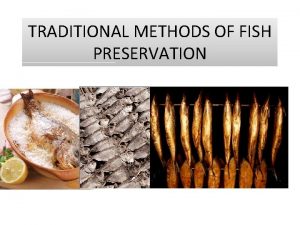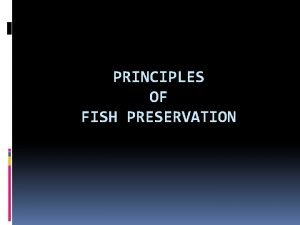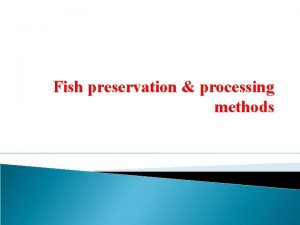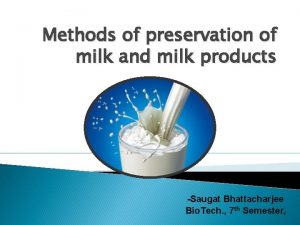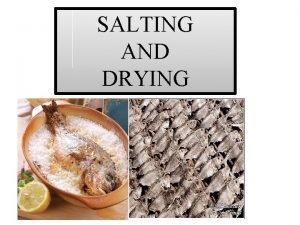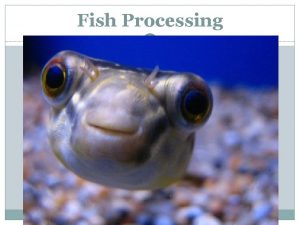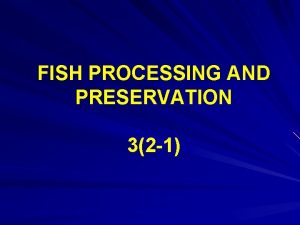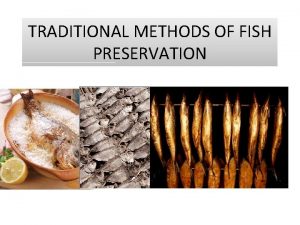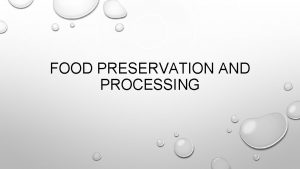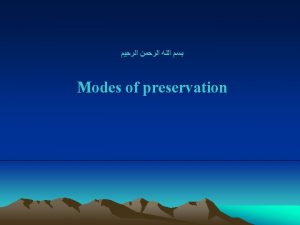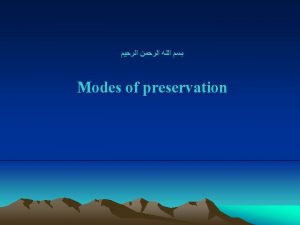Fish preservation processing methods Fish preservation and processing















- Slides: 15

Fish preservation & processing methods

Fish preservation and processing Fish preservation is a very important aspect of the fisheries. Normally the fish farms or other fish capturing sites are located far off from the market place and there is chance of fish decomposition and the uncertainties of their sale in market. When the fishes are caught in numbers, greater than the amount of consumption, their preservation becomes a necessity for their future use. It is done in such a manner that the fishes remain fresh for a long time, with a minimum loss of flavour, taste, odour, nutritive value and the digestibility of their flesh.

Methods of preservation Preservation can be done, both for short and long duration Preservation for short duration Chilling: This is obtained by covering the fish with layers of ice. Ice alone is not effective for long preservation, because melting water brings about a sort of leaching of valuable flesh contents. But ice is effective for short term preservation needed to transport landed fish to nearby markets or to canning factories, etc. Here autolytic enzymic activities are checked by lowering the temperature.

Contd. . Preservation for long time When the preservation is required for a long period of time, the fishes are passed through the cleaning, gutting and conservation and storage. Cleaning: During cleaning, washed the fish thoroughly in cold, clean water to remove bacteria, slime, blood, feces, and mud, etc. from the body surface of the fish. It is being done under proper sanitary conditions.

Contd. . Gutting: After cleaning, the fishes are cut along their mid ventral side, and their visceral organs are removed. By removing viscera, the bacteria in the gastro intestinal tract and enzymes of visceral organs are removed along with it to prevent bacterial decomposition and enzymic autolysis respectively.



Contd. . Conservation and storage: Conservation is necessary to keep the dead fish in fresh condition for quite a long time. This is achieved by employing any one of the methods like freezing, drying, salting, smoking and canning. Freezing: Freezing means removal of heat from the body. To check the enzymal, bacterial action and putrefaction it is preferred to store the fish under lower temperatures.

Contd. . The fishes are chilled in ice when stored for a few days. Ice is put inside the body cavity in large fishes. The fishes are arranged in tiers in shelves or boxes and stacked, and should not be dumped in heaps in cold storage. It is preferred to store at below 6. 60 C to prevent microbial spoilage of fish.

Contd. . Uses of ice: Fish preservation time can be extended by using ice. Ice reduces fish body temperature and keeps the body cool for more time. Water, formed due to ice melting, cleans the mucous, and other material of the fish body. Ice is useful as good preservative due to its melting point 0 C and latent heat 80 cal. /g. Due to high relative humidity of ice, it is very good for preservation. Ice is cheap and very effective preservative

Deep or quick freezing When fish is intended to be stored for a long period, quick freezing is preferred which inhibits bacterial action. During quick freezing every part of the product comes within the range of 0 o to -50 C. Properly frozen fish at -20 C retains its physical properties and nutritive values for a year or more and is almost as good as fresh fish. There are three ways effecting quick freezing: a) Direct immersion of fish in the refrigerating medium, b) Indirect contract with the refrigerant through plates and c) Forced convection of refrigerated air directed at heat transfer surfaces.

Freeze drying This is modified deep freezing, completely eliminating all chances of denaturation. The deep frozen fish at -20 o. C is then dried by direct sublimation of ice to water vapour with any melting into liquid water. This is achieved by exposing the frozen fish to 140 o. C in a vacume chamber. The fish is then packed or canned in dried condition. The product is quite fresh looking in appearance, flavour, colour and quality.

Filleting and freezing of fish Flesh cut parallel to the backbone of the fish. Fishes like milk fish, cat fish, perches, mullets, carps, eel, etc. , are suitable for filleting and freezing. Filleting can be done by hand which is economical or by using a filleting machine. Fillets may be with or without skin and it fetches a much higher price in the luxury market. Fillets are dripped in brine to enhance their appearance and to reduce the amount of drip and it also gives a salty flavour. The freezing of fillets can be an individual quick freezing of block freezing.

After dropping in brine, the fillets wrapped in polythene sheet and frozen in contact plate freezer at -350 C to -400 C. In block freezing the fillets in known weight 500 gm. , 1 Kg. , 2 Kg. are packed in polythene bags lined with wax and sufficient quantity of glazed water is poured to cover the fillets. The fillets are put in a freezer at -35 and stored at -230 C.

 One fish two fish red fish blue fish ride
One fish two fish red fish blue fish ride Methods of fish preservation
Methods of fish preservation What are the principles of fish preservation
What are the principles of fish preservation Fish preservation and processing
Fish preservation and processing One fish two fish blowfish blue fish script
One fish two fish blowfish blue fish script One fish two fish red fish lungfish
One fish two fish red fish lungfish Chemical preservation of food
Chemical preservation of food Milk preservation methods
Milk preservation methods Physical method of food preservation
Physical method of food preservation Direct wax pattern technique
Direct wax pattern technique What is the market form of beef steak
What is the market form of beef steak A big fish swims up and swallows a small fish at rest
A big fish swims up and swallows a small fish at rest 5 methods of salting fish
5 methods of salting fish Harvesting methods
Harvesting methods Kinds of fish and shellfish
Kinds of fish and shellfish Polymer processing methods
Polymer processing methods

